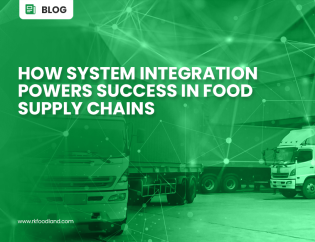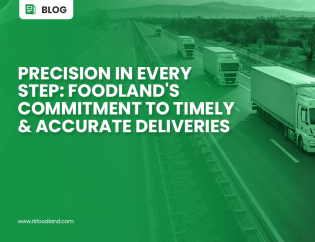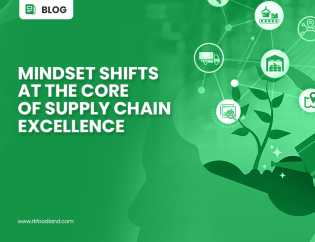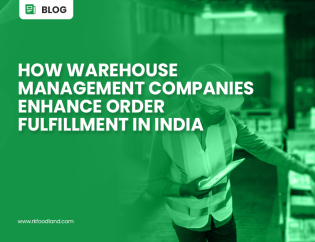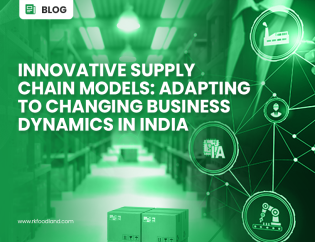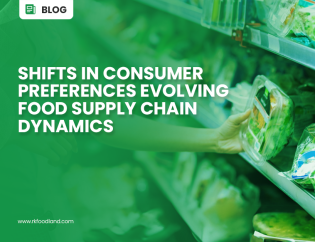
The Indian food industry has grown exponentially over the past two decades and is expected to grow at an 8% CAGR. Increased urbanisation and disposable income have led to the demand for convenient, packaged, branded foods and beverages. This demand is set to scale up tremendously, given that we have a huge young population. The industry is also characterized by a high degree of perishability of products, which requires an efficient and responsive supply chain. Traditional supply chains were built to connect the fragmented consumption centres across the country’s vast geography. This resulted in lengthy supply chains attracting a number of challenges, such as wastage, pilferage, and spoilage. Also, with a lack of integration, the total supply chain cost tends to rise.
To address the challenges faced by the businesses and create a conducive environment for them to grow, National Logistics Policy has been introduced. With this policy, the Indian government aims to reduce the cost of logistics in India to be comparable to global benchmarks by 2030; improve Logistics Performance Index ranking – endeavours to be among the top 25 countries by 2030; and create data driven decision support mechanism for an efficient logistics ecosystem.
This will be enabled through a series of key actions:
- Integrated Digital Logistics Systems: A system of unified logistics interface to link multiple data sources and develop cross sectoral use cases for logistics stakeholders.
- Unified Logistics Interface Platform (ULIP): A platform to gather all logistics & transportation sector digital services into a single portal, freeing manufacturers and exporters from long & cumbersome processes.
- Ease of Logistics Services (ELOG): A platform to allow industry to directly take up operational issues with the government agencies for speedy resolution.
- Service Improvement Group (SIG): A special committee to monitor all logistics-related projects regularly, reduce logistics problems and augment economy through employment generation.
- Standardization of physical assets and benchmarking of service quality standards: Standardization of transportation infrastructure (fixed and rolling), terminal handling, warehousing, temperature-controlled logistics, packaging, etc. to enhance interoperability and improve ease of doing business.
- Logistics Human Resource Development and Capacity Building: An overarching logistics human resource strategy to address skill development related and internal capacity building challenges.
- Services Improvement Framework: Elimination of fragmentation in documentation, formats, processes and liability regimes; reduce gaps in regulatory architecture.
- Facilitation of development of Logistics Parks: A framework guideline to facilitate development of logistics parks across the country and create a network for enhanced visibility, improved logistics efficiency, optimum utilisation and connectivity.
India’s food industry heavily relies on road transportation, accounting for roughly 60% of the total goods volume. Road transport has its own share of challenges, such as poor infrastructure, multiple checkpoints, traffic congestion, driver shortages and more. The government through National Logistics Policy (NLP) aims to create an ecosystem that aligns with the country’s growth plan. The national logistics policy provides a guideline for food businesses to ensure efficient and effective food supply chain management and be better prepared to be a part of this evolution.
1. Integrating logistics systems for better visibility and decision making
To align with the digital initiatives, businesses need to build a unified system to sync with the other participants across the value chain. This integration enables businesses with end-to-end visibility and traceability for course correction or to credibly make and verify product integrity claims. Digital capabilities like control tower allow businesses to remotely supervise fleets, including live temperature monitoring, location tracking and route optimization that improves on-time deliveries. With clear visibility of asset utilization in real-time, fleet management becomes more efficient and effective. As the food ecosystem is undergoing transformation, it is very important for businesses to develop the ability to sense the evolving consumer patterns and sentiments. Using advanced data processing tools, the same patterns can be used to predict demand and make informed decisions for better planning and fulfilment. Integration brings in standardization and digitization of systems to optimise the inconsistent operational processes and multiple documentation to reduce turnaround time, improve interoperability and ensure competitiveness. With integrated and standardized systems, identification of key performance indicators and establishing a performance review mechanism becomes easier. This ensures all participants align and cohesively perform towards a common goal, strengthening the overall supply chain capabilities. This seamless communication allows businesses to worry less about keeping up with the routine operational tasks and inspires to develop a shared viewpoint of highest standards using collective know-how.
2. Improving supply chain infrastructure for enhanced efficiency and reliability
With an increase in urbanization and digitalization in rural India, tier-II and tier-III cities have started to experience demand spike. To capitalize on this growing demand, the businesses are continuously improving or increasing their offerings, and to manage these SKUs & inventories it is important to have an optimal network design. Implementing a well-designed network not only gives a business better reach and penetration but also improves overall operational efficiency.
Digitizing warehouses allows businesses to monitor unit-wise performance and improve utilization in real-time. Standardization of warehousing practices and equipment enhances interoperability, ensuring competitiveness, efficient space utilization, inventory optimisation and reducing WET (wastages, errors & thefts). Most importantly, it improves customer service, increases order fulfilment rates and eventually adding more value and seamlessness to the overall supply chain. With the entire ecosystem responsible to perform and deliver assurance, a robust audit mechanism to identify their KPIs and periodically monitor them to track their performance should be established. These audit mechanisms are not only responsible for internal performance review but also cover external stakeholders like suppliers, vendors, logistic service providers, and others. Ensuring the entire ecosystem abides by the SOPs, and is outperforming the service quality standards and benchmarks to deliver assured supply chain outcomes.
3. Encouraging sustainable practices to ensure future relevance
Adoption of environmental sustainability, social inclusion, and a good governance plan can accelerate the operational, cultural, and financial changes required to build a future-proof food ecosystem. At present, the supply chain industry is characterized by unskilled workforce, driver shortage and tiring work schedules. To address these issues, businesses have to develop a fair and equitable work environment with a sense of responsibility towards the community through local employment, workforce upskilling, training programs, and developing a safe working condition for them to work in. Food businesses also need to focus on promoting sustainability in the supply chain through energy efficient operations, fuel efficient transportation powered by biodiesel and green fuel, eco-friendly packaging and circular supply chains aimed at repurposing waste and returns. This could be achieved through establishing governance policies and controls that ensure the business is done in true spirit, complying with the law and meeting stakeholder obligations.
The successful integration of ESG considerations into the supply chain offers a host of benefits, ranging from innovation, continuous product improvement and development, to the competitive advantages gained by demonstrating sustainability and meeting the expectations of a more aware and discerning customer base.
The National Logistics Policy, in conjunction with the other developmental schemes of the government i.e.: PM Gati Shakti – National Master Plan, can be transformational in enhancing infrastructural development. Strengthening the logistics sector will not only make it easier to do business but will also open up newer geographies and markets. To be better organised for this future, businesses should adopt the right mind set, aligned processes, skilled people and futuristic technology to optimise their supply chains. Irrespective of their size, sector and age, businesses should identify partners who better align with their vision powered by a common purpose. Developing positive synergy through ecosystem partnership will not only assure accelerated growth but will help create long-term value & future relevance.
To build a successful supply chain partnership in the food industry requires the right experience and expertise to manage the complexities. Understand from our experts how supply chain partnerships can open up new avenues to achieve growth, improve customer experience and build business assurance.
Connect with us to build a future-ready supply chain >

